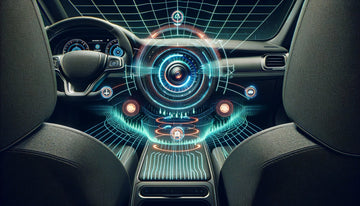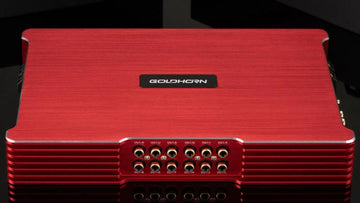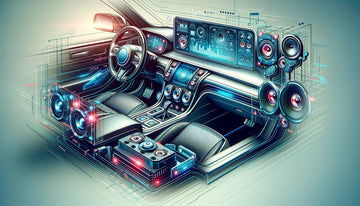Car audio enthusiasts strive to achieve their vehicles’ best listening experience. They invest in high-quality speakers, amplifiers, and subwoofers. But, they often overlook a crucial aspect of car audio: time alignment. Time alignment is a specific technique called 'time alignment.' It involves synchronizing audio arrival times from different speaker locations, including time alignment speakers to optimize the sound stage.
This optimizes the listening experience for all passengers. In this blog, we will explore the importance of car audio time alignment, including a comparison between time alignment vs phase alignment to help you understand the nuances. We’ll discuss its impact on sound quality. We’ll also talk about its practical benefits to the audio experience.
Employ advanced sound customization strategies with a DSP. Learn how by reading our Car Audio DSP Processor guide.
Introduction to Optimal Sound
Optimal sound quality in car audio systems is heavily dependent on accurate time alignment. Time alignment refers to the process of adjusting the timing of audio signals to ensure that sound from each speaker arrives at the listening position at the same time.
This is crucial for creating a cohesive and immersive audio experience. The listening position, typically the driver’s seat, plays a significant role in determining the optimal time alignment settings. By adjusting the time alignment, car audio enthusiasts can improve the sound quality, reduce phase issues, and create a more balanced audio image.
In car audio systems, the head unit, speaker locations, and frequency response all impact the overall sound quality, making time alignment a critical aspect of system setup.
Understanding Time Alignment in Car Audio

To understand the significance of time alignment, including the critical comparison of time alignment vs phase alignment, we must grasp the concept.
Basically, many common questions revolve around similar fundamental issues, and simplifying the advice can help address these concerns. In car audio, time alignment, including the adjustment for time alignment speakers, means adjusting the signal delay between speakers.
This ensures that audio reaches the listener’s ears at the same time. It compensates for discrepancies caused by speaker placement. This allows audio signals to align properly, ensuring car audio systems can deliver all occupants an immersive and balanced listening experience through accurate time alignment.
The Technicalities of Time Alignment
Time alignment involves adjusting the signal delay to synchronize audio arrival times. At its core, that’s what time alignment is. This change compensates for differences in speaker distances. Improper speaker wiring can cause sound to be delayed, leading to a diminished audio experience. It ensures that audio from all speakers reaches the listener’s ears simultaneously.
Achieving digital time alignment is crucial. It optimizes audio coherence and alignment within milliseconds. It uses digital signal processing (DSP) techniques. It uses high sample rates to accurately align the audio signal from each speaker location. Car audio systems can overcome timing discrepancies through precise time alignment. This results in a more cohesive listening experience and improved sound quality.
How Does Time Alignment Work?
Let's look closer at the process to understand how time alignment works. Car audio uses digital signal processing to sync audio from different speaker locations. This compensates for differences in speaker distances, giving everyone a centered listening experience. Time alignment improves spatial precision, sound staging, and sound quality. It does this by aligning audio arrival times. High pass, low pass, and crossover filters align and distribute audio signals across the speaker system to achieve this.
The Impact of Time Alignment on Sound Quality

Let’s now look at how time alignment affects sound quality. Getting the best sound quality depends on time alignment. Without time alignment, the audio can sound muddied and unbalanced, lacking in detail. Time alignment gets rid of differences in when the sound arrives by aligning audio signals from different speakers.
This makes the sound clearer and more accurate. It also ensures that sounds are in the right place. This makes the listening experience more immersive. Time alignment is crucial for getting great sound in car audio systems.
The Role of Time Alignment in Sound Staging
One of the key benefits of time alignment is its impact on sound staging. Sound staging refers to the stereo image’s perceived location and width of audio sources.
When unbalanced with the left speaker, sound from the right speaker can lead to an unsatisfactory listening experience, impacting the overall stereo sound quality and imaging. Time alignment contributes to precise left and correct speaker alignment. It optimizes sound staging in car audio systems. Time alignment enhances stereo imaging by aligning audio arrival times.
This creates a realistic and well-defined audio stage. It ensures that audio sources are correctly positioned. This enriches sound staging and creates a more immersive listening experience. Accurate time alignment achieves a centered, focused audio stage for car audio systems. This brings the music to life.
Time Alignment and Sonic Space Precision

Time alignment enhances sound staging. It also refines sonic space, creating a seamless audio experience for the listener. "Sonic space" refers to the spatial awareness and positioning of audio sources in a car stereo system. Precise time alignment optimizes audio coherence. It achieves precise time alignment within milliseconds. This results in impeccable sonic space alignment. This enhances the listening experience by:
- Ensuring accurate audio source positioning
- Enhancing sound imaging and definition
- Refining spatial awareness and stereo imaging
- Creating an immersive audio environment
How Time Alignment Enhances Clarity and Imaging

Time alignment has a significant impact on audio clarity and imaging. Synchronizing audio signals from many speaker locations sharpens audio clarity. It eliminates timing discrepancies that may cause audio distortions. The benefits of time alignment in enhancing clarity and imaging include:
- Synchronizing audio arrival times for a more coherent listening experience
- Eliminating time arrival discrepancies, improving audio signal coherence
- Reducing audio signal distortion, resulting in more precise audio reproduction
- Optimizing speaker signal alignment, enhancing audio imaging and spatial accuracy
- Enhancing the overall sound quality, delivering a well-defined and immersive listening experience
Does time alignment work for all types of music genres?

Yes, time alignment works for all types of music genres. Time alignment ensures that the sound from each speaker reaches the listener's ears at the same time, creating a cohesive and balanced audio experience regardless of the genre being played.
The Practical Benefits of Time Alignment

Now that we have explored the technical aspects and impact of time alignment. Let's delve into its practical benefits to car audio systems. Time alignment is essential for creating a balanced and immersive listening experience. It offers many advantages, such as:
- Achieving accurate audio signal alignment for optimal sound quality
- Ensuring audio reaches the listener's ears simultaneously, regardless of listening position
- Creating a center-stage listening position for every passenger in the car
- Optimizing audio signal alignment, resulting in a more immersive audio experience
- Fine-tuning time alignment settings for a well-balanced audio experience
Car Audio Time Alignment for a Lifelike Listening Experience
Time alignment has a remarkable benefit. It can create a lifelike and engaging music experience in car audio systems. Precise time alignment compensates for the varying distances of speakers from the driver's seat, allowing sound from each speaker to reach the listener simultaneously. Time alignment positions audio sources, enhancing the naturalness of music reproduction. Time alignment elevates audio spatialization, ensuring a captivating and realistic music experience. The advantages of time alignment for a lifelike music experience include:
-
Accurate audio alignment, delivering a high-fidelity music reproduction
-
Optimization of audio spatialization, creating a captivating and realistic music experience
-
Enhanced sound staging, providing listeners with a lifelike and immersive audio stage
-
A more immersive audio experience, truly bringing music to life in the car
-
Precise time alignment, contributing to natural and lifelike music reproduction
Time Alignment and Spatial Awareness

Time alignment is also crucial in enhancing spatial awareness in-car audio systems. The arrangement and phase alignment of speakers affect the sound reaching the listener's ear simultaneously, thus enhancing the overall audio experience and creating a more immersive sound stage. Time alignment refines the spatial positioning of audio sources by optimizing audio alignment. It maximizes spatial awareness and stereo imaging. The advantages of time alignment for spatial awareness include:
-
Sharpening spatial precision and accurately positioning audio sources for an immersive experience.
-
Refining audio stage positioning, maximizing spatial awareness, and stereo imaging
-
Contributing to enhanced spatial accuracy, creating a captivating and immersive listening experience
-
Optimal car audio time alignment, ensuring a well-defined and engaging audio stage
-
Precise alignment, optimizing spatial awareness, and delivering an immersive listening experience, especially from the driver’s seat
Creating an Immersive Audio Experience
Car audio Time alignment is critical to creating an immersive audio experience in car audio systems. A well-configured two-channel stereo setup with two speakers can enhance the auditory experience by ensuring that sounds arrive at the listener's position in a balanced manner, thereby improving the perceived depth and clarity of the audio. Achieving time alignment ensures that audio reaches the listener’s ears simultaneously. This happens regardless of the listening position. This creates a center-stage listening position for every passenger in the car. It enhances the audio experience. The benefits of time alignment in creating an immersive audio experience include:
-
Audio synchronization for all passengers, eliminating audio delays
-
Proper time alignment, resulting in a balanced audio experience
-
Enhanced listening experience, with audio tailored to each passenger’s position
-
Improved overall audio immersion, achieving a cohesive and engaging audio stage
Implementing Time Alignment in Your Vehicle

First, let's talk about how to use time delay in your car audio system. You must use equipment and adjust to get the best audio result to do this. Here are the steps to experience the benefits of time delay in your vehicle.
Necessary Equipment for Time Alignment

Specific equipment is necessary to optimize audio signal alignment to implement car audio time alignment. This equipment includes:
- Digital Signal Processing (DSP) units: DSP units can adjust signal delays, equalization, and crossover settings, facilitating precise time delay.
- Test Software: REW, Holm Impulse, JL Tun4, and Smaart are all great options.
- Crossover: Crossovers are essential for separating audio frequencies and directing them to the appropriate speakers, optimizing time alignment.
- Equalization (EQ): EQ settings allow fine-tuning of audio frequencies, achieving optimal and time alignment.
- Amplifiers: Amplifiers power the car audio system, providing the necessary signal strength for time delay adjustments.
With the right equipment, implementing time delay becomes crucial to achieving a balanced audio experience in your car.
Steps to Achieve Accurate Time Alignment
To achieve accurate time alignment, car audio enthusiasts should follow these steps:
-
Measure speaker distances: Determine the distance between each speaker and the listening position, ensuring accurate time alignment adjustments. Using Holm Impulse, along with a microphone, is a great tool for measuring distances.
-
Identify the closest speaker: Identify the closest speaker to the listening position, as it will serve as the reference point for time alignment adjustments.
-
Adjust time alignment settings: Fine-tune time alignment settings for each speaker, setting delay times in milliseconds to achieve synchronization.
-
Test and refine: Test the audio alignment and refine time alignment settings as needed, listening for improvements in sound staging, imaging, and clarity.
-
By following these steps, car audio enthusiasts can achieve accurate time alignment, optimizing the listening experience in their vehicles.
Fine-Tuning for Perfect Synchronization
Car audio enthusiasts should fine-tune their audio settings. This will achieve perfect synchronization in time alignment. This fine-tuning allows for precise alignment. It ensures that audio signals reach the listener's ears at the same time.
-
Continuously fine-tune time alignment settings for all speakers, considering speaker distances and listening position.
-
Pay attention to audio coherence and clarity, adjusting delay times to optimize sound quality.
-
Regularly test audio alignment and refine time alignment settings as necessary, striving for the perfect balance in audio synchronization.
-
By carefully fine-tuning time alignment, car audio enthusiasts can achieve optimal audio signal alignment, delivering a well-balanced and synchronized listening experience.
Advanced Techniques in Time Alignment

Car audio enthusiasts seek to enhance the listening experience. Reflective surfaces can create echoes that negatively impact audio quality, making it essential to understand both dispersion and reflection for optimizing time alignment. Advanced car audio time alignment techniques offer further optimization. These techniques address specific challenges and considerations beyond basic time alignment adjustments. Implementing advanced car audio time alignment techniques can enhance the listening experience. It can optimize sound quality. It can also overcome common alignment challenges in car audio systems.
Overcoming Challenges in Time Alignment
In-car audio systems with complex speaker setups often face challenges with time alignment. The interaction of different drivers within a stereo setup is crucial to achieving optimal sound quality and imaging. Overcoming these challenges is important to achieve the best audio alignment. Some common challenges include:
-
We are aligning speakers in car stereo setups with tweeters, mid-range, and subwoofers that require precise synchronization.
-
It balances time alignment across multiple speaker locations, ensuring consistent audio coherence.
-
Fine-tuning time alignment for different audio frequencies, optimizing alignment for each speaker in the system.
-
Overcoming alignment discrepancies caused by speaker placement, ensuring audio arrives simultaneously from all speaker locations.
-
By understanding and addressing these challenges, car audio enthusiasts can optimize time alignment in their systems, enhancing sound quality and the overall listening experience.
Tips for Optimizing Time Alignment Settings
To optimize time alignment settings in-car audio systems, consider the following tips:
-
Adjust digital time alignment settings to achieve optimal audio signal alignment.
-
Fine-tune high pass filters, low pass filters, and crossover settings for precise audio alignment.
-
Consider default time alignment settings as a starting point, fine-tuning them based on speaker locations and distances.
-
Check speaker polarity to ensure proper alignment and synchronization.
-
Utilize equalization settings to optimize audio alignment and reinforce time alignment adjustments.
-
By optimizing time alignment settings, car audio enthusiasts can achieve a well-balanced and synchronized audio experience in their vehicles.
How does time alignment differ from phase alignment in car audio systems, and why does it matter?
Time alignment and phase alignment both play critical roles in optimizing the sound quality of car audio systems. The idea that effective sound staging is crucial for achieving high-quality audio in vehicles cannot be overstated. Time alignment focuses on synchronizing the audio signals from different speakers so that they reach the listener’s ears simultaneously, ensuring a cohesive soundstage.
Phase alignment, on the other hand, involves adjusting the phase of audio signals to prevent phase cancellation, where overlapping frequencies from different speakers cancel each other out, leading to a loss in audio clarity and quality. Both alignments are essential for achieving a clear, balanced, and immersive listening experience in your vehicle.
What are the auditory signs that your car audio system might require time alignment adjustments?
Auditory signs that suggest your car audio system may need time alignment adjustments include a lack of clarity in the sound, with instruments and vocals sounding muddled or out of place. Achieving proper time alignment enhances the sound quality, resulting in more distinct and intricate details in the music. You might also notice that the soundstage seems skewed, with some sounds appearing closer or further away than intended. Another indicator could be a lack of cohesion in the audio, where the bass, mids, and highs do not seem to blend smoothly, leading to a disjointed listening experience.
How Has Time Alignment Improved Your Audio Experience?
We would love to hear about your experiences with time alignment in car audio. Many enthusiasts face challenges with car audio setups, and sometimes it’s necessary to leave certain configurations behind and return purchased equipment when they fail to deliver the desired sound experience.
How has time alignment improved your audio experience? Time alignment is vital in delivering high-quality audio. Whether it’s enhanced sound staging, spatial accuracy, or listening experience. Share your story and highlight the benefits you have noticed. Explain how time alignment has transformed your car audio system. Time alignment ensures an immersive, balanced listening experience for all occupants. Whether in the driver’s seat, passenger side, or enjoying the audio from the rear.
It would help if you used time alignment to make your car audio sound better. It’s an important technique that improves the way your sound system works. Car Audio Time alignment makes your music sound clearer and more realistic. It also helps you hear the different parts of the music more clearly.
To use time alignment in your car, you need the right equipment and you need to adjust it. But it’s worth the effort because your music will sound much better. Don’t settle for average sound in your car when you could have amazing sound with time alignment. Try it for yourself and hear the difference.

Troubleshooting Common Issues
Troubleshooting common issues in time alignment is essential for achieving optimal sound quality. One of the most common issues is phase problems, which can cause sound to appear unbalanced or muddy. To address this, car audio enthusiasts can use techniques such as fine-tuning the delay added to each speaker or adjusting the crossover frequency.
The mic position and sample rate also play a crucial role in determining the accuracy of time alignment. By using a microphone to measure the distance between the speaker and the listening position, enthusiasts can set the time alignment settings to ensure that sound from each speaker arrives at the same time. Additionally, understanding the concept of stage inches and how to adjust the stage shift can help to correct the stage’s alignment without affecting the time alignment. On the passenger side, phase issues can be particularly problematic, but by using the correct techniques and equipment, these issues can be resolved.
Conclusion and Best Practices
In conclusion, achieving optimal sound quality in car audio systems requires careful attention to time alignment. By understanding the importance of time alignment and how to troubleshoot common issues, car audio enthusiasts can create a more immersive and engaging listening experience.
Best practices include using a microphone to measure the distance between the speaker and the listening position, fine-tuning the delay added to each speaker, and adjusting the crossover frequency as needed. Additionally, considering the frequency response, speaker locations, and head unit settings can help to optimize the sound quality.
By following these best practices and staying up-to-date with the latest techniques and technologies, car audio enthusiasts can take their systems to the next level and enjoy a more detailed and engaging sound.
Whether listening to music or talk, a well-tuned car audio system can make all the difference, and with the right knowledge and equipment, anyone can achieve optimal sound quality.





